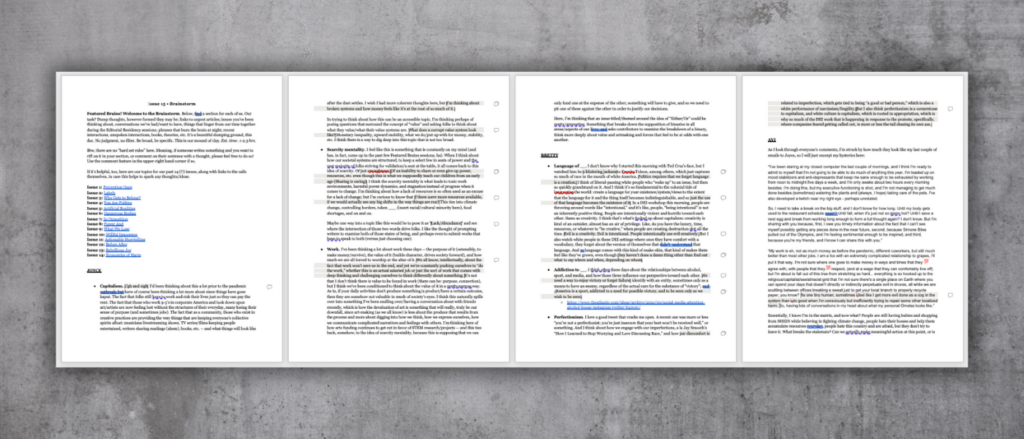Each issue we publish is a labor of love that begins long before we launch it out into the world. In fact, we consider every issue to officially kick off when we create a new Google doc in anticipation of the months-long process we undertake to create our call for submissions, which we call our “Featured Brains” program.
Three-and-a-half months before a call for submissions opens up, we reach out to several contributors from the previous issue to gauge their interest in partaking in what we called the “Featured Brains” process. Altogether, we look to gather anywhere between four to seven contributors to help us shape the call; on average, there are usually three TSW team members who get in on the mix as well. Then, we give them the lay of the land: we create the call via three different Google docs, each a different phase of the process that gets us closer to the three-paragraph prompt that folks will eventually respond to. And in this way, we create an important bond between contributors from different issues — a subtle conversation, a shared heartbeat.
Phase 1: The Brainstorm begins.
For the first phase, which we call “Brainstorm,” we ask each contributor or team member to offer up a brain dump of what they’re thinking about, what questions they’re asking, what subjects they’re curious to know more about, what types of things they’re having conversations with their besties about. It is, essentially, a free-for-all. The point of the brainstorm is to get a comprehensive snapshot of what folks are interested in at this particular moment in time; our calls are meant to be both timely and timeless, and this is how we address the former.

Phase 2: The Braincalm.
After everyone has shared their thoughts — which can often lead to a dynamic, multi-page Google doc — we move into the second phase, which we call “Braincalm.” Here, one of the TSW team members will take a look at what folks have dropped into the Google doc and start to identify themes or threads. Then, they create a new Google doc that rearranges everyone’s thoughts based on topic, pulling key phrases or sentiments from each contributor and team member’s brain dump. The featured brains then dive into this second Google doc and respond to what speaks to them, either adding to the conversation in a long comment thread or simply upvoting a particular turn of phrase.

Phase 3: The Mindblown.
Based on this activity, we move into the third and final phase, which we call “Mindblown,” or more colloquially, the first draft of the call. It falls upon that same TSW team member who created the “Braincalm” Google doc to parse through the conversations and upvotes to create a rough sketch of the call, a three-paragraph prompt that pulls from the questions and curiosities found in the previous two phases. Usually, a framework for the call becomes clear after the “Braincalm” phase, but sometimes there are multiple possibilities, so the TSW team member has to think about what framing will keep the call as accessible to folks as possible, as open to interpretation as a call can be. The point is to ask questions that will spark ideas or reactions and encourage writers and artists from a wide range of backgrounds, viewpoints, and disciplines to submit.

Phase 4: The issue takes a form of its own.
Then comes the bonus phase, which is simply finessing the call itself. The contributors and team members hop into the newly created “Mindblown” Google doc once the call draft is written and offer up suggestions to make it stronger — a word choice here, a different phrasing there. In all, this three-phase process takes about three months, but at the end of it all, we’ve collectively created a call that will hopefully reach multiple communities and spark dialogue that will last long past the duration of the issue itself. Timely and timeless is the name of the game, after all. Oftentimes, once we finish a call, we highlight all the sections that were a direct result of one of our Featured Brains’ sentiments during this process to show just how collective the call is. Below, you can see one such example:

Take a moment to explore some of our past calls for submissions and see for yourself; many of the questions posed even seven or eight years ago are still very relevant today.



